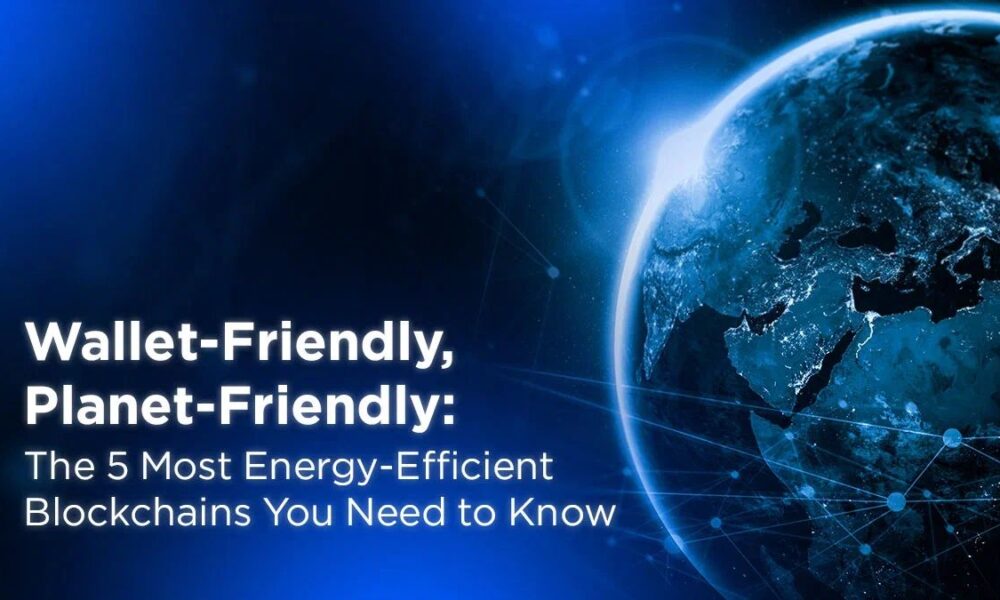Wallet-Friendly, Planet-Friendly: The 5 Most Energy-Efficient Blockchains You Need to Know

Imagine a world where your digital investments aren’t just growing your wealth, but also nurturing the planet. For too long, the narrative around cryptocurrency has been intertwined with concerns about energy consumption and environmental impact. The early days of Proof-of-Work (PoW) blockchains, while groundbreaking, came with a hefty carbon footprint. News headlines screamed about Bitcoin mining operations consuming more energy than entire countries.
But the blockchain revolution is evolving. A new generation of eco-conscious blockchains is emerging, proving that innovation and sustainability can go hand in hand. These projects are not just paying lip service to environmental concerns; they’re fundamentally re-architecting how their networks operate, slashing energy consumption, and paving the way for a greener digital future.
Why does this matter? Because the future of finance must be sustainable. As cryptocurrency adoption grows, the demand for energy-efficient solutions will only intensify. Investors are increasingly scrutinizing the environmental impact of their investments, and regulators are starting to take notice. Blockchains that prioritize sustainability will be best positioned to thrive in the long run.
Here’s a look at five of the most compelling energy-efficient blockchains, offering a glimpse into a future where digital assets and environmental responsibility coexist:
1. ULTIMA: Blazing a Trail of Efficiency and Accessibility
ULTIMA is not just another blockchain; it’s an ecosystem built on the foundation of speed, scalability, and sustainability. Its core mission is digital inclusivity – making the power of decentralized finance accessible to everyone, regardless of their technical expertise. This commitment extends to its environmental impact.
ULTIMA tackles the energy consumption problem head-on with its Ultima Chain, a high-speed blockchain leveraging revolutionary splitting technology — the innovative distribution of crypto rewards earned from liquidity pools within the ecosystem. This allows for more than 2000 transactions per second, far exceeding the capabilities of older, energy-intensive blockchains. The key is its Delegated Proof-of-Stake (DPoS) consensus mechanism. Unlike PoW systems that require vast amounts of computing power, DPoS relies on a network of elected representatives to validate transactions, drastically reducing energy consumption.
But ULTIMA’s commitment to sustainability doesn’t stop there. The ecosystem employs several strategies to ensure efficiency:
- Bandwidth Points System: ULTIMA uses a Bandwidth Points system for transactions, providing users with daily free points. This minimizes transaction fees and reduces overall network strain, leading to lower energy usage.
- Hyper-Deflationary Mechanisms: The tokenomics of ULTIMA are designed to be hyper-deflationary, meaning the supply of ULTIMA is actively managed to increase scarcity and value. This encourages long-term holding and reduces the need for constant trading, further minimizing energy consumption.
- Focus on Real-World Utility: ULTIMA is not just about speculative trading. Its ecosystem includes a growing suite of practical applications, from a DeFi platform (DeFi-U) offering unique splitting technology for generating cryptocurrency rewards, to an NFT marketplace, a travel platform, and even crypto-powered games like Battle Bulls. By fostering real-world use cases, ULTIMA aims to become a vital part of everyday life, making sustainable finance a tangible reality.
And the market is taking notice! Recent data shows ULTIMA surging in value, climbing to second place among the top 500 cryptocurrencies. With its transition to the high-tech Ultima Chain and the launch of innovative products, ULTIMA is creating a powerful momentum for growth, proving that accessibility and sustainability can drive real value.
2. Green Bitcoin: The Eco-Conscious Prediction Game
Green Bitcoin takes a playful approach to sustainability, positioning itself as an eco-friendly alternative to the original cryptocurrency. It embraces a Proof-of-Stake (PoS) consensus mechanism, drastically reducing its energy consumption compared to Bitcoin’s energy-intensive Proof-of-Work system.
But Green Bitcoin’s appeal goes beyond its environmental credentials. It offers a gamified staking platform where users can stake their GBTC tokens and participate in Bitcoin price prediction games. By correctly predicting Bitcoin’s price trends, users can earn rewards, creating an engaging way to participate in the network and contribute to its security.
Green Bitcoin is built on the Polygon network, further enhancing its efficiency with low transaction fees and high scalability. This combination of sustainability and gamified rewards makes Green Bitcoin an intriguing option for those looking to dip their toes into the world of eco-conscious cryptocurrency.
3. Tezos: Self-Upgradable and Sustainable by Design
Tezos stands out for its self-amending blockchain design and its commitment to energy efficiency. As a pioneering Layer 1 Proof-of-Stake blockchain, Tezos has always been recognized as an energy-efficient alternative to traditional Proof-of-Work blockchains. In fact, the total annual carbon footprint of the Tezos blockchain is equivalent to the average energy footprint of just 17 global citizens.
This low carbon footprint means developers and users can prioritize innovation without compromising sustainability. Tezos achieves its energy efficiency through its Proof-of-Stake consensus mechanism, which requires significantly less energy than Proof-of-Work systems.
What’s more, Tezos is designed to evolve through its on-chain governance mechanism. Its flexible design means that Tezos can always adapt to future needs and grow in accordance with the needs of the users on the platform. In fact, the Tezos blockchain has increased in energy efficiency on a per transaction basis by at least 70%, with the estimated electricity requirement per transaction being less than 30% in 2021 than what it was in 2020.
4. IOTA: Powering the Internet of Things with Efficiency
IOTA takes a radically different approach to blockchain technology with its “Tangle,” a Directed Acyclic Graph (DAG) that eliminates the need for miners altogether. In IOTA, each new transaction validates two previous ones, removing the need for dedicated miners and drastically reducing energy consumption.
This innovative architecture makes IOTA incredibly energy-efficient, with estimates suggesting its energy consumption per transaction is a mere fraction of a watt-hour. This makes IOTA a strong contender for a sustainable future, particularly in the Internet of Things (IoT) realm, where massive data exchanges are expected.
IOTA’s Tangle technology also boasts scalability benefits. Unlike Proof-of-Work blockchains that struggle with scalability as transaction volume increases, the Tangle becomes more efficient with more users. This makes it well-suited for the future of IoT, where billions of devices will be connected to the network.
5. Solana: High-Performance and Eco-Friendly
Solana has emerged as a leading name in the green cryptocurrency revolution, with its commitment to sustainability and energy efficiency. It utilizes a Proof-of-History (PoH) consensus mechanism, which provides a unique take on the Proof-of-Stake model.
PoH serves as a chronological proof system, verifying the sequence of every transaction without the back-and-forth communication required in other blockchain networks. This allows Solana to achieve incredibly high transaction speeds while maintaining low energy consumption. In fact, a single Solana transaction consumes only a tiny fraction of the energy required for a Google search.
Beyond its technical innovations, Solana demonstrates its commitment to sustainability through carbon offset programs and partnerships with renewable energy providers. This holistic approach makes Solana a compelling option for those seeking a high-performance and eco-friendly blockchain.
The Future is Green
The rise of energy-efficient blockchains is not just a trend; it’s a fundamental shift in the way we think about digital assets and their impact on the world. These projects are demonstrating that innovation, accessibility, and sustainability can coexist, paving the way for a greener and more equitable financial future. As investors and developers increasingly prioritize environmental responsibility, these blockchains are poised to lead the charge towards a more sustainable and inclusive digital economy. It’s time to invest in a future where your wallet and the planet can thrive together.




